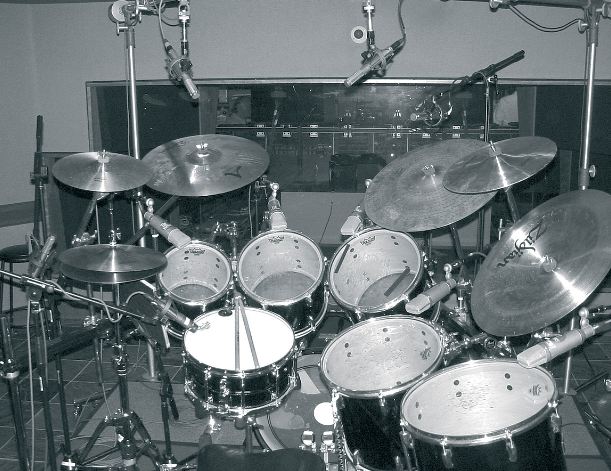Drum mixing tips.
First, there are likely a thousand and seven different ways to mix drums. These are only suggestions how to mix drums in your music tracks. Live drums (real drums). Not sampled or triggered drums.
So now that you’ve had all this time to record drums, and have most likely more drum tracks than you need to get a good sound (because overkill is cool and is pretty much the foundation of rock, anyway, so go for it! give me 27 drum tracks, let’s do this!)… now that you have the drums recorded, how do you mix drums?
Before starting your drum mix (or doing any mixing at all) you want to make sure that you have some perspective and an understanding of the song. You don’t want to go for a flappy, country kick drum sound if it’s a death metal song, just as much as you don’t want a rubbery funk kick drum sound if it’s a pretty broken-love ballad that inevitably also has a mellow cello in the track somewhere ;) Kiss of death number one for mix engineers is bringing too many pre-conceived notions to the table. You have a drum sound that you like best, but it might not be the best for the song or the record. Never forget that.
Most people will start with the driving forces of kick and snare drum. Your kick should cut through, but you gotta be careful that it doesn’t overwhelm the low end – people tend to get carried away very quickly when mixing a kick drum; they focus too hard on it and forget about the rest of the mix. Use compression to help control the low end (particularly multi-band compressors if you have any). In general, the more you compress a kick drum (greater gain reduction) the less low end it will have b/c you’re basically squashing that range first. Be very careful, though, because too much compression on your kick drum will make it sound very flat and sterile, it will lose a lot of its life and natural sound. Don’t be afraid to explore very high frequencies as well to bring out more of the skin sound of the attack (not just the mid and high-mid range for the cutting attack, you want the skin, too). If you used two mics to record the kick drum, try reversing the phase on one and bringing it up and down in the blend, that will also have a huge impact on the low end (just be careful, as always, when dealing with phase).
Start your snare drum by focusing on leveling the “THWACK!!!” aspect. “Leveling” in that you control the dynamics as much as you can (again, multi-band compression is helpful here). The purpose is so that it doesn’t cut out here and there requiring you to automate the fader level too much. If you have a bottom mic on the snare, don’t over do it, and above all else do NOT try to get the bottom mic to sound good on its own. Use it for its purpose: bringing out the snare sound. Blend, blend.
NOTE ON USING SUBGROUPS WHILE MIXING (click it to jump)
If you have multiple mics on both the snare and kick drum, now that you have a blend going, bus them to mono subgroup faders (removing the original from the left / right mix so you’re not double monitoring) and use the subgroup of each for some final EQing and sum compression of the combined signals. Don’t do much, and you might not even need it. The point is so that you can have one fader for the kick and one fader for the snare to mix your levels.
Go to your hi-hat and put a high-pass filter on it to get rid of basically everything below 3-400Hz (unless you have something funky going on where you’ll want the “belly” of the hi-hat). Listen for some odd ringing that can happen around 600Hz and 900Hz. You can soften it a lot by using a wide Q (low Q value), setting your frequency around 3k, and dipping down some. 2-3kHz are particularly harsh, and 4.5kHz can almost sound like it’s whistling at you. Go very high (8-12k) to seek out some softer sizzle sound… or do the total opposite of all that to get a more lo-fi, 60’s sounding hi hat… up to you ;)
Gate your toms but be VERY careful b/c when they open you’ll get bleed from the cymbals which can be jarring. Give it a range that’s not too extreme so that the gates don’t attenuate fully. Also listen very carefully for clicking when the gate opens (means your attack time is too fast). There’s another post on POLITUSIC about EQing tom drums, so check that one out for more info. If you have a lot of toms, go ahead and buss to a stereo subgroup (so you panning is maintained, but don’t pan too extreme, that can sound strange on headphones) and there you can play around with either using the subgroup independently (removing the original tracks from the L/R mix), or compressing the *&%&^*&% out of it and using as a parallel compression technique to help stabilize the dynamics (be very careful about phase issues if doing the latter option).
Cymbals and overhead mics can be a pain. Having room mics can help soften their sound a lot (room mics for drums in a good sounding studio can make a huge difference), but if you have tracks where the drummer is just pounding away on splashes and crashes all the time, the intensity of all those vibrations in general makes it hard to get clarity without making your ears bleed. So: tube them if you got ’em. Do some basic EQing, then send to a stereo subgroup (NOT parellel compressing, so remove all the originals from the L/R mix), then insert a nice tube EQ and compressor, which can help soften it up. If compressing, be VERY gentle, have a long attack time and short release time (sometimes the attack longer than the release).
By now there’s a good change you’ve over compressed and over EQ’d a lot of your signals (it happens). So walk out of the room, turn around three times, shake your head, and go back in to listen w/ cleaner ears. Back off the processing a bit if you think it needs it.
USING SUBGROUPS WHILE MIXING:
Subgroups are your friend. Subgroups are NOT mix groups. What makes a subgroup a subgroup is that signal passes through them and they can have inserts, EQs, dynamics, be assigned to the mix or routed to even more subgroups. Most smaller consoles have dedicated subgroups, while on larger consoles, any channel fader can be “turned into” a subgroup fader by use of a little routing and signal flow knowledge. Keep in mind: normally you need to remove the original tracks (the ones you send to the subgroups) from the L/R mix after you assign them to the subgroup, because if you don’t you’ll be double monitoring, which basically sounds like &*^*&^&%^!@#. There are rare occasions when you don’t do this (parallel compression), but if you’re still learning, just get into the good habit of removing tracks from the L/R mix that you’ve assigned to subgroups so that you know you’re not double monitoring anywhere.























